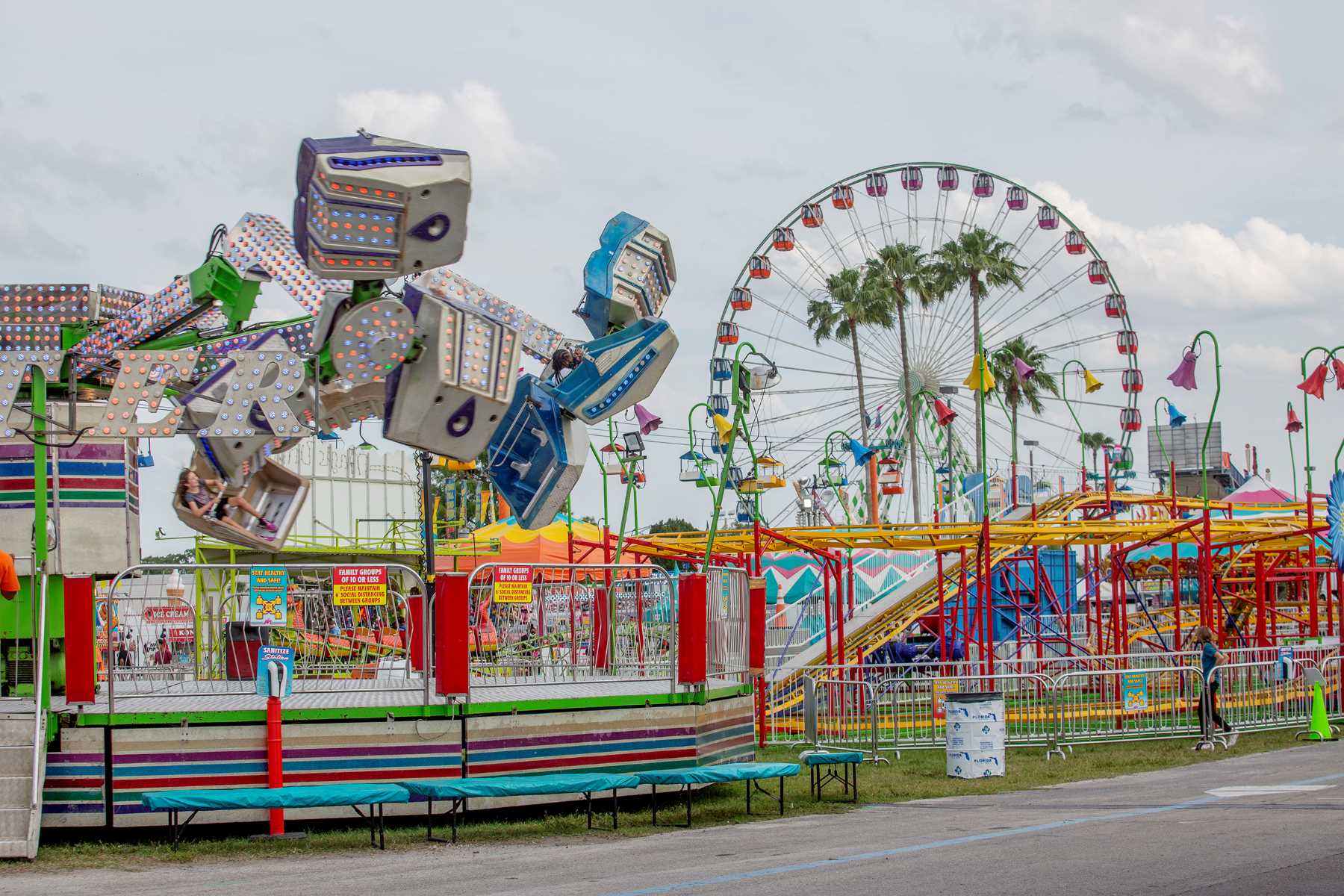
State fairs are beloved events that bring together communities from across the country to celebrate culture, agriculture, entertainment, and all things fun. These annual spectacles offer a unique experience filled with thrilling rides, delicious food, live music, exhibitions, and much more. From the giant Ferris wheels and jaw-dropping circus acts to the mouthwatering deep-fried treats and mesmerizing fireworks displays, state fairs never fail to capture the hearts and imaginations of attendees.In this article, we will delve into some fascinating facts about state fairs that will not only pique your curiosity but also give you a glimpse into the rich history and traditions surrounding these iconic events. Whether you’re a seasoned fair-goer or have yet to experience the joy of a state fair, get ready to be amazed by these 20 surprising and entertaining state fair facts.
Key Takeaways:
- State fairs have a rich history dating back to the 1800s, showcasing agriculture, livestock, and entertainment, offering a fun and educational experience for all visitors.
- From deep-fried delicacies to butter sculptures, state fairs are a celebration of creativity, culture, and community, providing a platform for diverse experiences and learning opportunities.
The origin of state fairs can be traced back to the agricultural societies of the 19th century.
State fairs have a rich history that dates back to the 1800s, where they were originally organized by agricultural societies to showcase the advancements in farming and livestock breeding. These events provided a platform for farmers and breeders to display their produce and animals, exchange knowledge, and compete for awards.
The Great Minnesota Get-Together, also known as the Minnesota State Fair, is one of the largest state fairs in the United States.
Every year in late summer, the Minnesota State Fairgrounds in St. Paul come alive with a vibrant celebration of agriculture, entertainment, and culinary delights. With an annual attendance of over 2 million people, it offers a wide range of attractions, including rides, horse shows, concerts, and of course, a diverse selection of food on a stick!
The first-ever Ferris wheel made its debut at the 1893 World’s Columbian Exposition, which was essentially a state fair held in Chicago.
Invented by George Washington Gale Ferris Jr., this iconic attraction revolutionized the amusement industry and has since become a staple at state fairs around the world. The Ferris wheel offers a bird’s-eye view of the fairgrounds, giving visitors an unforgettable experience and a chance to take stunning panoramic photographs.
State fairs are famous for their mouthwatering deep-fried delicacies.
From deep-fried Oreos to deep-fried butter, state fairs are known for pushing the boundaries of culinary creativity. These indulgent treats may not be the healthiest options, but they are undeniably delicious. Visitors often flock to the fairgrounds to satisfy their cravings for deep-fried goodness.
State fairs often feature live performances by popular musicians and artists.
Music is a vital part of the state fair experience. From country and rock concerts to local bands and up-and-coming artists, the fairgrounds come alive with the sounds of live music. These performances provide entertainment for fairgoers of all ages and create a lively and festive atmosphere.
Livestock competitions are an integral part of state fairs.
Agriculture and livestock continue to play a significant role in state fairs. Livestock competitions showcase the finest specimens of different breeds, where judges evaluate animals based on criteria such as conformation, size, and health. These competitions celebrate the hard work and dedication of farmers and offer educational opportunities for fair visitors.
State fairs often host competitions and exhibits for arts and crafts.
State fairs are not just about agriculture and entertainment; they also provide a platform for artists and crafters to showcase their talents. Visitors can explore exhibits featuring paintings, sculptures, photography, quilts, pottery, and various other artistic creations. Competitions are held to recognize the best works and encourage creativity among participants.
The Iowa State Fair has been running for over 160 years.
Established in 1854, the Iowa State Fair is one of the oldest and most prestigious state fairs in the country. It attracts millions of visitors each year with its wide array of attractions, including livestock shows, agricultural exhibits, concerts, and even butter sculptures!
The Big Tex statue at the Texas State Fair is one of the most recognizable symbols of any state fair.
Standing at a whopping 55 feet tall, Big Tex is a towering figure that greets visitors as they enter the fairgrounds. Clad in denim jeans and a cowboy hat, he represents the deep-rooted Texan spirit and serves as a welcoming icon for fairgoers from around the world.
State fairs often offer thrilling rides and amusement park attractions.
For those seeking adrenaline-pumping excitement, state fairs feature a variety of rides and amusement park attractions. From roller coasters and Ferris wheels to spin rides and bumper cars, there is something for everyone, regardless of age or thrill-seeking level.
The Minnesota State Fair has its own radio station, providing fair-related news and updates.
To keep fairgoers informed about daily events and activities, the Minnesota State Fair operates its own radio station. Visitors can tune in to stay up to date with live interviews, fairground announcements, contests, and even performances by local musicians.
State fairs are a great platform for local businesses to showcase their products and services.
From artisanal food vendors and craft breweries to small-scale manufacturers and local service providers, state fairs offer an opportunity for businesses to promote and sell their products directly to a large and diverse audience. It creates a platform for economic growth and supports the local economy.
The New York State Fair holds the distinction of being the oldest state fair in the United States.
Founded in 1841, the New York State Fair has a long and storied history. It continues to thrive and attract millions of visitors annually with its wide range of attractions, including agricultural exhibits, live performances, food vendors, and a spectacular fireworks display.
State fairs often have designated days to celebrate different cultures and ethnicities.
To promote diversity and celebrate the cultural heritage of different communities, state fairs often have designated days or showcases dedicated to specific ethnicities. From parades and cultural performances to traditional food and art exhibits, these events promote understanding and appreciation of different cultures.
State fairs provide educational opportunities through interactive exhibits and workshops.
State fairs are not just about entertainment; they also offer valuable educational experiences. Interactive exhibits and workshops cover a wide range of topics, including agriculture, technology, environmental conservation, and wildlife preservation. Visitors can learn about these subjects through hands-on activities and engaging demonstrations.
The Wisconsin State Fair is known for its competitive cream puff eating contest.
One of the highlights of the Wisconsin State Fair is the cream puff eating contest, where participants compete to devour as many of these iconic pastries as possible within a specified time limit. The competition is fierce, and the event attracts both participants and cheering spectators.
State fairs often feature rodeo events and showcases of Western culture.
For fans of rodeo and Western culture, state fairs are a must-visit. Rodeo events such as bull riding, barrel racing, and team roping attract both professional cowboys and enthusiastic spectators. Additionally, fairgrounds often feature Western-themed attractions, including cowboy boot vendors, western wear fashion shows, and even line dancing lessons.
The Ohio State Fair has a tradition of butter sculptures.
Butter sculptures have become a cherished tradition at the Ohio State Fair. Highly skilled artists use butter as their medium to create intricate and detailed sculptures that capture the imagination of fairgoers. From famous landmarks to iconic figures, these sculptures are a unique and captivating sight to behold.
State fairs often have agricultural education programs for children.
Recognizing the importance of educating future generations about agriculture, state fairs often have dedicated educational programs for children. These initiatives aim to teach kids about farming practices, animal husbandry, and the importance of sustainable agriculture in a fun and interactive way.
The State Fair of Texas is famous for its massive livestock shows.
As the largest state fair in terms of attendance, the State Fair of Texas takes its livestock shows seriously. Visitors can witness impressive displays of cattle, poultry, sheep, and more. Livestock breeders and exhibitors compete for prestigious awards, and fairgoers have the opportunity to learn about farm animals up close.
Conclusion
The state fair is a beloved tradition that brings people from all walks of life together to celebrate local culture, entertainment, food, and agriculture. With its rich history and diverse attractions, the state fair never fails to captivate visitors of all ages. From thrilling rides to agricultural exhibits and live performances, there is something for everyone to enjoy. Whether you are a fan of deep-fried treats, live music, or competitive games, the state fair promises an unforgettable experience year after year.
FAQs
1. When and where does the state fair take place?
The state fair typically takes place during the summer months and is held at a designated fairground within the state. The exact dates and location vary from state to state, so it’s best to check the official state fair website for specific details.
2. How much does it cost to attend the state fair?
Ticket prices for the state fair vary depending on factors such as age, day of the week, and any additional attractions or exhibits. It’s recommended to check the official website or local ticket vendors for accurate and up-to-date pricing information.
3. What can I expect to find at the state fair?
The state fair offers a wide array of attractions, including carnival rides, live entertainment, agricultural exhibits, food vendors, arts and crafts displays, and much more. You can also expect to find competitions, contests, and special events throughout the duration of the fair.
4. Are there any special events or performances at the state fair?
Yes, the state fair often features special events and performances such as concerts, fireworks displays, talent shows, and animal shows. These events may require separate tickets or have limited seating, so it’s advisable to plan and secure tickets in advance if you wish to attend.
5. Can I bring my own food to the state fair?
Most state fairs allow attendees to bring their own food, but specific policies may vary. Some fairs may prohibit outside food or have restrictions on coolers or large containers. It’s recommended to check the state fair’s guidelines or contact the organizers for clarification before bringing outside food.
6. Is parking available at the state fair?
Yes, state fairs typically provide designated parking areas for attendees. However, parking availability and costs may vary. It’s advisable to arrive early or consider using public transportation, if available, to avoid any inconvenience.
State fairs offer a delightful glimpse into American culture, with their rich history and unique traditions. If you enjoyed learning about these fascinating state fair facts, why not explore more? Discover the charm of the Virginia State Fair, where agricultural exhibits and thrilling rides await. Experience the grandeur of the Minnesota State Fair, known for its incredible food and live entertainment. Don't miss out on the larger-than-life attractions at the Texas State Fair, including the iconic Big Tex statue. Each state fair has its own distinctive character, promising unforgettable memories for visitors of all ages.
Was this page helpful?
Our commitment to delivering trustworthy and engaging content is at the heart of what we do. Each fact on our site is contributed by real users like you, bringing a wealth of diverse insights and information. To ensure the highest standards of accuracy and reliability, our dedicated editors meticulously review each submission. This process guarantees that the facts we share are not only fascinating but also credible. Trust in our commitment to quality and authenticity as you explore and learn with us.


